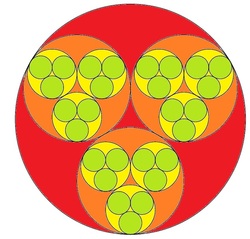Circular Fractal Patters
 Fractal Images are formed by geometrically repeating a pattern infinitely. Take for example the figure shown. Three smaller circles of equal radii are inscribed in a greater circle, where each smaller circle is tangent to the greater circle and the other two smaller circles. Then, each of the smaller circle circumscribes another set of even smaller circles of equal circles.
Fractal Images are formed by geometrically repeating a pattern infinitely. Take for example the figure shown. Three smaller circles of equal radii are inscribed in a greater circle, where each smaller circle is tangent to the greater circle and the other two smaller circles. Then, each of the smaller circle circumscribes another set of even smaller circles of equal circles.
Let us say that the great circle drawn is a unit circle and we keep on drawing and drawing and drawing smaller circles following the pattern. What would the sum of the area of all the circles drawn in two decimal places?
The answer is 8.88.
This section requires Javascript.
You are seeing this because something didn't load right. We suggest you, (a) try
refreshing the page, (b) enabling javascript if it is disabled on your browser and,
finally, (c)
loading the
non-javascript version of this page
. We're sorry about the hassle.
Consider one big circle with three smaller circles. if we join the centres of the three small circles, we see that the centre of the bigger circle is the centroid of that triangle. let C be centre of big circle and C1 be centre of any small circle. We have CC1+r=R by observation. For CC1 we use the above triangle. we shall get that CC1= (2/(sqrt3))r. Following this and solving we get [2(sqrt3)-3]R=r. This is now a Geometric Progression. But the trick was adding the increasing number of circles.. That's where my first attempt went wrong :p Cheers!